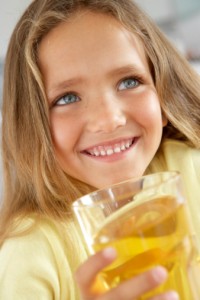What’s Really in Your Child’s Juice?
 It’s common to see a toddler or preschooler holding a cup filled with apple or grape juice; kids naturally like the sweet juice, and parents feel good about giving them a product made from fruit, particularly one that says “100% Juice” or “No Added Sugar.” Is it a good idea to let kids drink juice all day, though? It’s been known for a long time that too much juice can contribute to obesity, tooth decay and digestive maladies such as “toddler’s diarrhea,” but are there other dangers lurking in your child’s drink of choice?
It’s common to see a toddler or preschooler holding a cup filled with apple or grape juice; kids naturally like the sweet juice, and parents feel good about giving them a product made from fruit, particularly one that says “100% Juice” or “No Added Sugar.” Is it a good idea to let kids drink juice all day, though? It’s been known for a long time that too much juice can contribute to obesity, tooth decay and digestive maladies such as “toddler’s diarrhea,” but are there other dangers lurking in your child’s drink of choice?
According to Consumer Reports, some name brands of juice commonly given to children contain arsenic and lead. Here are some facts:
Arsenic in Juice
The federal government has placed a limit of 10 parts per billion, or ppb, when it comes to a safe level of arsenic that’s in drinking water. Although there is no “safe” level of arsenic for juice, several brands, including Great Value, Motts and Apple & Eve had some samples that exceeded 10 ppb. The type of arsenic found in some juice samples was inorganic, which is the type posing the greatest risk. Symptoms of the arsenic ingestion include skin lesions and digestive problems. There is speculation that this exposure could raise the risks of developing skin, bladder, lung or liver cancer.
Lead in Juice
If you live in a home built prior to 1978, your pediatrician may recommend that your young children be tested for lead exposure, particularly if you also have peeling paint or if there is chipping paint in places like windowsills or door frames. The reason for this is that lead poisoning can cause developmental delays in children, including delayed growth, as well as hearing loss and hyperactivity. Some brands of juice contained lead, possibly from lead-laden insecticides that are no longer used in the United States, but may be in the soil and may be used in other countries.
So, what’s the answer? Do we need to stop giving our kids juice altogether? Probably not, but it’s a good idea to talk with your pediatrician about your child’s juice consumption. It’s also important to follow the AAP’s guidelines and limit your child: Kids under age six should drink no more than 6 ounces of juice per day, and kids over age six shouldn’t drink more than 12 ounces per day. If your child drinks more than this, begin cutting back and diluting his juice with water. Since juice contains calories that your child might not need, switching to water for most of his fluid needs can reduce his risk of becoming obese, as well as lowering his exposure to dangers like lead and arsenic.
Another good tip is to look at where your child’s juice is coming from. If the juice is processed in China, Argentina or other foreign countries, the standards may differ from those of the United States. Consider buying juice processed in North America and also consider switching to organic to reduce the risks of the pesticides used.
It can be worrisome to think about whether a product that you’re giving your kids contains harmful additives, so be sure to ask your child’s doctor any questions that you have about this topic!








